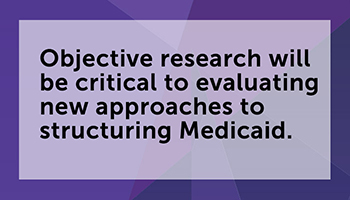The Healthy Indiana Plan (HIP) has received a lot of attention recently as journalists, commentators, and policy analysts scrutinize HIP 2.0, the current version of the plan, and assess the likely future of Medicaid under the new administration. What lies ahead for Medicaid is still not clear, as Secretary of Health and Human Services Tom Price and Centers for Medicare & Medicaid Services (CMS) Administrator Seema Verma take on federal leadership for Medicaid. Given that HIP 2.0 could influence the direction of Medicaid reform, this is a good time to review what we learned from Mathematica’s evaluation of HIP’s early years from 2008 to 2014, or HIP 1.0.
When HIP was implemented in 2008, it was the first Medicaid program to include a high-deductible spending account for members, known as a Personal Wellness and Responsibility (or POWER) account, partially funded by members’ monthly contributions. The theory is that by requiring members to help pay for their health coverage, they would become more cost-conscious consumers. Our evaluation provided the state and CMS with considerable information about demonstration outcomes, but the findings relating to the monthly POWER account contributions, which follow, might be particularly important for the current policy discussions.
- Five years into the program, HIP covered about 40,000 people each month and most (77 percent) paid monthly contributions.
- Of those who made monthly contributions, more than 80 percent of members surveyed in 2013 reported they could afford the monthly amount. Among former members living in poverty, about 73 percent thought their monthly contributions were affordable.
- When asked whether they were willing to pay $5 more each month to remain in HIP, the majority reported “yes.” Among members making contributions, 94 percent were willing to pay $5 more each month, and 82 percent of members not making a contribution reported a willingness to pay $5 a month to keep their HIP coverage.
- Administrative data indicated that about 10 percent of HIP members disenrolled in 2012 because they failed to make their monthly contributions. Among the former HIP members Mathematica surveyed in 2013, 14 percent cited cost as a factor for leaving the program and 12 percent reported they left because they did not keep up with their monthly contributions.
Mathematica’s evaluation of HIP informed the state’s negotiations with CMS for a five-year renewal of the demonstration and the creation of HIP 2.0, which continues to include monthly contributions, but the structure and size of the contributions differ somewhat from those in HIP 1.0. The monthly contributions have caused concern among some, but they are foundational to the argument that enrollees must be invested in the program to reign in Medicaid costs. Mathematica’s evaluation suggested that most members seemed to value the program and were willing to contribute toward the costs of their care, with some contributing as much as $97 each month. However, Mathematica never assessed the extent to which people did not apply for HIP because they didn’t think they could afford the monthly contributions.

One reason why members valued HIP was their need for healthcare. Administrative data indicated that chronic conditions were relatively common among HIP members; 51 percent had three or more chronic conditions. Mental health conditions were also prevalent; we estimated that 24 percent received care for a psychiatric diagnosis while enrolled in HIP, and an additional 18 percent obtained prescriptions for psychiatric conditions. HIP also began operating during the Great Recession, when unemployment rates were rising and securing insurance coverage was challenging, another reason why HIP members might have valued the program more than being uninsured.
Mathematica’s evaluation of HIP demonstrated that different approaches to structuring Medicaid benefits can work, at least for some people who are not medically frail or do not have disabling and high-cost conditions. As a Medicaid demonstration, HIP operates alongside Indiana’s traditional Medicaid program. Like most demonstrations, HIP can probably be improved and there are many questions about HIP that have been left unanswered. We still don’t know who among the eligible population doesn’t apply or sign up because of the program’s monthly contributions or whether the administrative costs of managing the POWER accounts are offset by the benefits of the program. In addition, we have no evidence of how long HIP members remain cost-conscious consumers after they leave the program. Demonstrations such as HIP benefit from ongoing research that addresses a wide range of questions. All stakeholders can learn more about alternative approaches to covering and delivering care to low-income populations.
As more states develop and implement new approaches to structuring Medicaid and delivering care to low-income populations, ongoing objective research will be critical in determining what works for whom and under what conditions. Most likely one size does not fit all when it comes to Medicaid, and traditional and new approaches can exist side-by-side as they have in Indiana.


